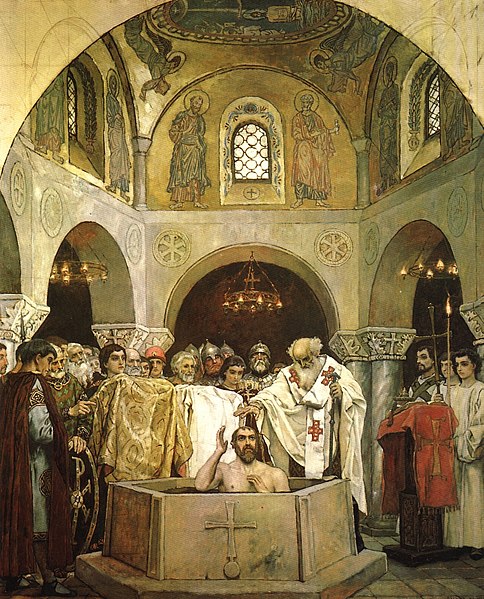 Today is the feast of St. Vladimir I of Kiev (956-1015), honored alike in the Catholic and orthodox churches as the man who Christianized the people of Kiev. He is patron, among other things, of Russia, of converts, of parents with large families and -- murderers.
Today is the feast of St. Vladimir I of Kiev (956-1015), honored alike in the Catholic and orthodox churches as the man who Christianized the people of Kiev. He is patron, among other things, of Russia, of converts, of parents with large families and -- murderers.The first thing that strikes one on reading a sketch of St. Vladimir's life is that he was not a very nice person -- certainly not before his conversion, and maybe, just possibly not even then. He made war on his brother, whom he eventually slew after the latter surrendered; slew a prince and took his daughter to wife; took several other wives and numerous concubines, by whom he had a boodle of children (hence his patronage of people with large families); and set up a great many shrines devoted to Slavic pagan gods. In an interesting parallel with my favorite obscure saint, King St. Aethelberht of Kent (who must surely have prayed for him), St. Vladimir started out as a committed pagan. St. Aethelberht was a worshipper of Odin, who demanded human sacrifices, usually by strangulation or hanging from trees in sacred groves; it is thought that Vladimir may himself have participated in rituals involving human sacrifice.
Although Christianity was quietly and secretly blossoming in the lands under his rule, it was not until 987, while planning a campaign against the Graeco-Roman empire, that he began to be interested in Christianity. He sent envoys to study the religions of various neighboring lands, and received glowing reports about the Divine Liturgy celebrated at Hagia Sophia in Constantinople. Thus was the finger of God, as Whittaker Chambers put it, laid on his forehead.
But unlike St. Aethelbehrt, who had possessed a great deal of natural goodness and decency even before his conversion, Vladimir was still far from exhibiting those virtues for which the saints are often renowned. In 988, after beseiging the city of Kherson in the Eastern Roman Empire, Vladimir sent an embassy to Emperor Basil II of Constantinople asking for his sister Anna's hand in marriage, and threatening to march on Constantinople if he refused. The Emperor replied that a Christian could only marry another Christian, so only if Vladimir were a Christian prince could he sanction such a match. Vladimir replied that he had studied the Christian faith and was inclined favorably to it, so that he was ready to accept Baptism.
Which baptism took place that same year, as depicted above by the Russian artist Viktor Vasnetsov. Vladimir followed it up by marrying Anna, returning the city of Kherson, returning to Kiev with his new bride, getting rid of all his other wives and concubines, and setting about expunging paganism from within his borders. Catholic Encyclopedia describes the opening of his campaign:
When Vladimir returned to Kieff he took upon himself the conversion of his subjects. He ordered the statues of the gods to be thrown down, chopped to pieces, and some of them burned; the chief god, Perun, was dragged through the mud and thrown into the River Dnieper. These acts impressed the people with the helplessness of their gods, and when they were told that they should follow Vladimir's example and become Christians they were willingly baptized, even wading into the river that they might the sooner be reached by the priest for baptism. Zubrycki thinks this readiness shows that the doctrines of Christianity had already been secretly spread in Kieff and that the people only waited for an opportunity to publicly acknowledge them.
Vladimir did become known as a mild and devoted ruler (having given up warmongering), and was zealous for the spread of the Christian faith. Although two of his sons were later recognized as saints in their own right (Boris and Gleb), his later life was dogged by the intransigence of some of his older children. Vladimir died on the march north to deal with his rebellious son Yaroslav in 1015, and his feast is celebrated on July 15th.
Vladimir's conversion and subsequent recognition as a saint provide us with a striking example of the powers of Baptism, even in the case of a man with multiple murders on his conscience, whose appallingly evil life should have landed him in the bowels of Hell. Mere good will on Vladimir's part -- especially mixed as it appears to have been, at least in the beginning, with political motivations -- could never have been enough to give him the purpose of amendment he obviously exhibited after Baptism, let alone save his soul. Here is proof, if more is needed, that Baptism is no mere symbol.
St. Vladimir is my husband's patron saint!
ReplyDeleteI've been reading a bunch of blogs tonight and stumbled onto yours. Great blog! I'm really enjoying it. :)
Jessica
Jessica, glad you like the blog, and glad to see a western devotee of St. Vladimir.
ReplyDeleteThose who search for "diversity" really need look no farther than the calendar of saints. A cloud of witnesses from all over the world and all walks of life -- from children who never lost their baptismal innocence to actors, soldiers, lawyers, doctors, hunters, and even theives and murderers and womanizers who gave up their sins and embraced holiness. If a guy like St. Vladimir can give up his multitudinous and entrenched vices, who among us has an excuse for not doing the same?